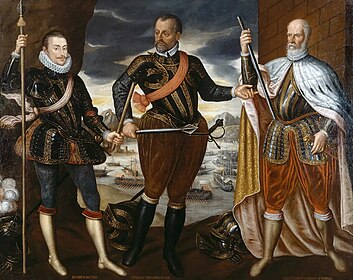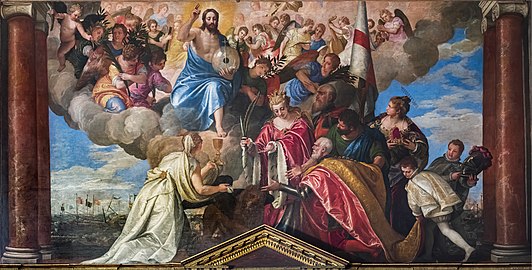Sebastiano Venier
| Sebastiano Venier | |
|---|---|
 Sebastiano Venier at the Battle of Lepanto. Painting by Tintoretto | |
| Doge of Venice | |
| Reign | 1577 – 1578 |
| Predecessor | Alvise I Mocenigo |
| Successor | Nicolò da Ponte |
| Born | 1496 Venice |
| Died | 3 March 1578 Venice |
| Burial | |
| Spouse | Cecilia Contarini |
| Father | Mosè Venier |
| Mother | Elena Donà |
| Religion | Roman Catholicism |
Sebastiano Venier (or Veniero) (c. 1496 – 3 March 1578) was Doge of Venice from 11 June 1577 to 3 March 1578. He is best remembered in his role as the Venetian admiral at the Battle of Lepanto.
Biography[edit]
Venier was born in Venice around 1496. He was a son of Moisè (Mosè) Venier and Elena Donà,[1] and a nephew of Zuan Francesco Venier, Co-Lord of Cerigo.[2][better source needed] He was a paternal grandson of Moisé Venier (ca. 1412 - ca. 1476).[3] He was the great-great-great-grandson of Pietro Venier, Governor of Cerigo.[4]
He worked as a lawyer from a very early age, though without holding formal qualifications, and subsequently was an administrator for the government of the Republic of Venice. In 1570 he was procurator of St Mark's and, in the December of the same year, capitano generale da Mar of the Venetian fleet in the new war against the Ottoman Turks, substituting Girolamo Zane.[5]
He was the commander of the Venetian contingent at Battle of Lepanto (7 October 1571), in which the Christian League decisively defeated the Turks. After the peace he returned to Venice as a very popular figure, and in 1577, at the age of 81, he was unanimously elected Doge.[1]
He was married to Cecilia Contarini, who bore him a daughter, Elena Venier. He also had two illegitimate sons, Filippo and Marco.[6][7] Venier later provided Filippo with a benefice and Marco, who became a functionary of the chancellery, with a post in Dalmatia.[8][5]
Sebastiano Venier died on 3 March 1578.[5]
He was interred in the Santa Maria degli Angeli of Murano, instead of the family's tomb, as he had expressed in 1568 in his will. However, in 1907 his remains were moved in the Basilica di San Giovanni e Paolo, a traditional burial place of the doges.[5]
Relations[edit]
There is a possibility that he was a first cousin once removed of Cecilia Venier-Baffo, known as Nurbanu Sultan after her conversion to Islam, daughter of his first cousin Nicolò Venier, Lord of Paros.[9] She was abducted during the Ottoman–Venetian War (1537–1540) and sent to the Ottoman Sultan Suleiman the Magnificent[2] in order to counter the ascension of Roxelana. She became eventually the wife of his son Selim II and the mother of Murad III, from whom descend all succeeding Sultans.[10]
-
Coat of arms of Sebastiano Venier
-
The Victors of Lepanto (from left: John of Austria, Marcantonio Colonna, Sebastiano Venier)
-
Votive Portrait of Doge Sebastiano Venier by Veronese
-
Funeral effigy in the Basilica di San Giovanni e Paolo
References[edit]
- ^ a b Brunetti, Mario. "VENIER, Sebastiano". Enciclopedia Italiana. Archived from the original on 23 August 2021. Retrieved 23 August 2021.
- ^ a b Ancestry of Sultana Nur-Banu (Cecilia Venier-Baffo)
- ^ Mihail-Dimitri Sturdza, Dictionnaire Historique et Généalogique des Grandes Familles de Grèce, d'Albanie et de Constantinople, Paris: Sturdza, 1983, p. 446
- ^ Mihail-Dimitri Sturdza, Dictionnaire Historique et Généalogique des Grandes Familles de Grèce, d'Albanie et de Constantinople, Paris: Sturdza, 1983, p. 445
- ^ a b c d Gullino, Giuseppe. "VENIER, Sebastiano". Enciclopedia Italiana. Archived from the original on 23 August 2021. Retrieved 23 August 2021.
- ^ Arturo Segre (1899). "MOLMENTI POMPEO, Sebastiano Veniero e la battaglia di Lepanto. Firenze, Barbera, 1899". Rivista storica italiana. Vol. 16. Edizioni scientifiche italiane. p. 39.
- ^ Molmento, Pompei. Sebastiano Veniero E La Battaglia Di Lepanto: Studio. Nabu Press. pp. 9–10. ISBN 978-1-276-12354-9.
- ^ Zorzi, Alvise (1990). La vita quotidiana a Venezia nel secolo di Tiziano Part 3, Volume 10. Rizzoli. p. 115. ISBN 978-88-17-16755-0.
- ^ Brusegan, Marcello (2006). I personaggi che hanno fatto grande Venezia artisti, letterati, scienziati e avventurieri: le storie e i protagonisti di una delle città più affascinanti del mondo. Newton Compton. p. 419. ISBN 978-88-541-0684-0.
- ^ A. D. Alderson, The structure of the Ottoman dynasty, Oxford: Clarendon, 1956, Table XXXI et seq., for details.




